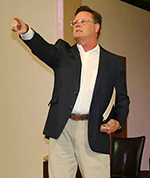BOULDER, Colo. (BNG)—Preaching often gets lost in today’s urgent talk about church decline, closure and relevance. Most of the buzz centers on embracing technology, social media, worship styles or whether to stay in or sell the building.
 But what about homelitics? Where does the message from the pulpit fit into debates on “nones,” “dones” and the Millennials? Do those groups care about sermons as passionately as they are said to care about music and missional service?
But what about homelitics? Where does the message from the pulpit fit into debates on “nones,” “dones” and the Millennials? Do those groups care about sermons as passionately as they are said to care about music and missional service?
Direct experience and research shows they do, and a few recent developments seem to prove that while preaching is evolving, it’s still considered important and effective.
For instance, the Lilly Endowment has issued several large grants to seminaries— including Baylor University’s Truett Theological Seminary—to strengthen preaching.
Another indicator: Luis Palau will join other evangelists for four days of worship, song and preaching—plenty of preaching—in New York City in February.
But it isn’t just the high-profile preachers who are putting a lot of thought into preaching, especially when it comes to reaching young people.
‘It was very powerful’
“Millennials tell me that what matters are not preachers’ degrees or where they went to school, but that they are authentic,” said Bob Ballance, the senior minister at Pine Street Church—formerly First Baptist—in Boulder, Colo.
The once-dwindling congregation has experienced resurgence in recent years as the American Baptist church has become a magnet for Millennials.
Sign up for our weekly edition and get all our headlines in your inbox on Thursdays
 Bob BallanceTo reach that generation, preachers must not pander to them with awkward references to social media or references to the latest films or television shows, Ballance insisted.
Bob BallanceTo reach that generation, preachers must not pander to them with awkward references to social media or references to the latest films or television shows, Ballance insisted.
They’re also not interested in the basic “three points and a poem” sermon model, he said.
“They want real stories from life,” he said. “They want sermons that really matter—not just a devotional thought.”
Preaching to an increasingly young congregation has required a change in his approach, Ballance said. He left traditional preaching behind in the mid-’90s and started incorporating technology like PowerPoint. That’s evolved to using film clips when appropriate, and he also tried passing out pen and paper to have congregants describe their image of God.
“I was shocked. I got 70 written, prophetic responses,” he said. “It wasn’t just me talking. It was the congregation. It was very powerful.”
Balance’s 15- to 20-minute sermons have gone by different names.
“We used to call them ‘reflections,’ and sometimes ‘meditations,’” he said. “In the last couple of months, we are back to ‘sermon.’”
The purpose of the sermon isn’t necessarily to evangelize, Ballance said.
“It’s a time of guided reflections. It’s not me having all the answers,” he said.
‘Still drawing a crowd’
The tension pastors face in the modern pulpit is between relevance and irrelevance, said Brett Younger, associate professor of preaching at Mercer University’s McAfee School of Theology. And both positions can be challenging, he added.
Being irrelevant means speaking truth many people are not interested in, he said.
 Brett YoungerOn the other side, preachers may stretch so far toward relevancy their sermons offer little more than self-help tips for becoming better in the culture. And it works.
Brett YoungerOn the other side, preachers may stretch so far toward relevancy their sermons offer little more than self-help tips for becoming better in the culture. And it works.
“Look at Joel Osteen. He’s still drawing a crowd,” Younger said.
Preachers trying to convey the gospel message face yet another challenge—avoiding overly religious language.
“If you use religious language without time to flesh it out, then people have trouble hearing it,” Younger said. “But if you completely dump it, you may not be telling the story of Christ any more.”
That’s why, for the first time in hundreds of years, that sermons actually are getting longer, he added. It’s occurring because Christian education has moved from Sunday school to pulpits.
“Teaching is its only function in a lot of settings,” Younger said of preaching.
Whatever form or technique is used, sermons should teach about topics that hit people where they live, he asserted.
“Millennials will tell you they want authenticity and reality” in sermons, he said. “They will tell you they want someone to talk about things that matter ultimately.”
‘A sea change’ in preaching
Helping students learn how to preach in ways that are faithful and engaging with congregations is one of the hoped-for benefits of the $500,000 grant from the Lilly Endowment, said Hulitt Gloer, professor of Christian scriptures at Truett Seminary.
Gloer is among the faculty members who will oversee portions of the grant, which will be used to create peer-learning and peer-coaching opportunities for students.
 Hulitt GloerLilly approached Truett about the grant—as it did seven other schools—prompted by concern about the quality of preaching in American churches, Gloer said.
Hulitt GloerLilly approached Truett about the grant—as it did seven other schools—prompted by concern about the quality of preaching in American churches, Gloer said.
Of course, Truett jumped at the opportunity.
“We’re always looking for better approaches … and opportunities to do some experimentation and develop better methods of pedagogy,” Gloer said.
The basics still will be taught, but in innovative ways, he noted.
To help with voice and projection, preaching students will interview drama department personnel. Courses will cover preparation, discovering and using resources, and developing topics.
But Truett long has been engaged in helping its students find their way in an ever-changing church and cultural environment, Gloer said.
A major consideration is how faculty prepare students to preach before technologically savvy generations.
“This is a big question in homiletics in general,” Gloer said. “What does this sea change mean for the preaching event?”
















We seek to connect God’s story and God’s people around the world. To learn more about God’s story, click here.
Send comments and feedback to Eric Black, our editor. For comments to be published, please specify “letter to the editor.” Maximum length for publication is 300 words.